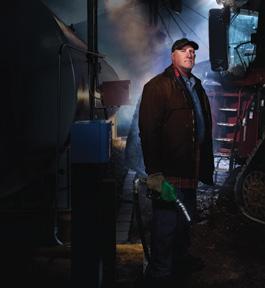
2 minute read
Community Oil
Headline in the July 6, 1939, Sioux Center News on the day before the first rural electric cooperative member was “energized.”

Advertisement
TYPICAL DIESEL? THAT’S LIKE LEADING YOUR TRACTOR OUT TO PASTURE.
A more complete additive package for a more complete burn. Keeping your off-road engines on point.
LEARN MORE AT CENEX.COM/RUBYFIELDMASTER

Diesel that doesn’t mess around.
© 2019 CHS Inc.
WHERE SERVICE IS STILL IN STYLE. Call us for your Cenex fuel, propane and lubricant delivery needs.
Electrification Administration. Based in Orange City, the Sioux County organization was loaned $250,000 in 1938. The founding board of visionaries included George Boerhave, Fred Vander Ham, Russell A. Patrick, Peter Moeller, Fred Dawson, Alvin Linch and H.J. Shoemaker. Eugene C. Mulder of Orange City was named general manager of the Sioux Electric Cooperative Association in 1939, a position he held for more than 40 years. On June 30, 1938, the Sioux Center News reported that the Sioux County Rural Electrification project “is really a combination of two highline projects which have been intermittently brought to the public’s attention during the last two years. The first project originated around Hawarden, the second around Boyden. Both enterprises were started about the time of the establishment of the Rural Electrification Administration in Washington in May 1935.” During the first year of its operation, the Sioux County cooperative built 228 miles of power lines. By October 1938, it had connections with 440 farms, rural residences and rural business places. In its July 6, 1939, edition, the Hawarden Independent reported “JUICE TURNED ON JUNE 30TH. The William Nibbelink farm home near Orange City was the first patron to receive electric service from the Sioux County rural electrification project.” Fifteen homes in the county were energized on the first day. It took five, 10 or even 15 years for rural electrification to reach some farms in the country. But when the juice came on in a county or region, the word “drudgery” began to fade on the family farm. Electricity changed the lives of farm families, from the moment they got up early in the morning, through meals, chores, and work until they went to bed at night. Electricity revolutionized farm work. Now livestock water tanks were filled by electric pumps and barns had power for devices like electric milk machines and egg counters. Greater efficiencies allowed farmers to expand. Electricity brought changes that just made life safer and better, according to Wessel’s Living History Farm. “Electricity brought power for lights to work, read and sew at night; power for appliances like refrigerators and freezers to preserve food; power for small kitchen devices such as mixers and blenders; and power for other labor saving devices such as electric stoves, irons and clothes washers.” Combined with the advent of the automobile, rural electrification did much to eliminate the disadvantages that threatened to stigmatize farm life into a second-class existence. In addition, electrification allowed farmers to better feed the burgeoning urban population.










